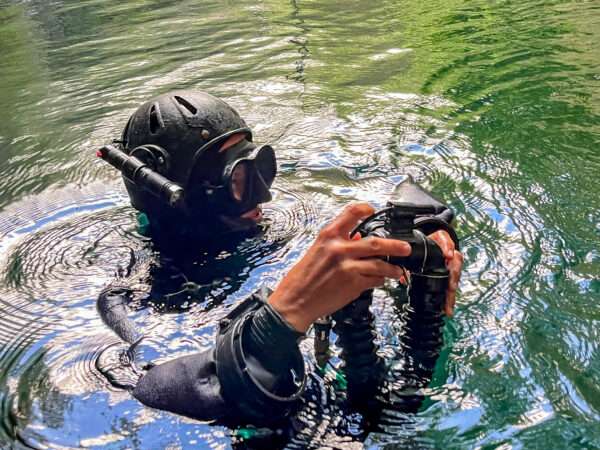Are you ready to embark on an exciting journey into rebreather diving? The decision to explore the world of closed-circuit rebreathers (CCR) marks the beginning of an extraordinary adventure. As you gear up for this transformative experience, let’s explore what awaits you in a CCR diving course —your gateway to underwater exploration like never before.
- Mastering the Theoretical Foundations of Rebreather Diving
- Instrument Set-Up: A Crucial Pre-Dive Ritual to CCR Diving
- Pool Training: Nurturing Confidence in a Controlled Environment
- CCR Diving Course: Real Experience in Open Water
- Emergency Preparedness: Navigating Challenges Underwater while Diving a CCR
- Embracing a New Paradigm: The Post-CCR Diving Course Transformation
- Pick Your CCR Instructor
Mastering the Theoretical Foundations of Rebreather Diving
Before you take the plunge into the underwater world with a rebreather, building a solid theoretical foundation is crucial.
The CCR diving course typically encompasses 8 to 12 hours of theoretical instruction on Rebreather diving, covering essential topics such as:
- Device operation
- Different types of rebreathers
- Configurations
- Oxygen sensors
- CO2 absorption
- Breathing dynamics with the rebreather
- Physiology

Physiology is a pivotal chapter in this phase, shedding light on the unique challenges posed by rebreather diving and equipping you with the knowledge to navigate potential risks.
Understanding that rebreathers can expose you to physiological gas levels uncommon in open circuit diving, your training will also focus on dive planning and gas management. A skilled instructor will involve these insights into a cohesive narrative, empowering you to make informed decisions in critical moments throughout your future CCR dives.
Instrument Set-Up: A Crucial Pre-Dive Ritual to CCR Diving
Setting up your rebreather instrument correctly is a critical aspect of your training. A well-assembled and thoroughly tested unit before each dive forms the cornerstone of a safe underwater experience. Your instructor will ensure you can operate the equipment confidently and without hesitation, emphasizing the importance of this pre-dive checks for your safety.
Pool Training: Nurturing Confidence in a Controlled Environment

Diving into a pool or confined water environment provides a safe space to familiarize yourself with the behavior of the rebreather apparatus underwater. Basic exercises and habit-building activities will enhance your comfort and confidence, laying the groundwork for a smooth transition to open-water exploration. While one pool session is typically sufficient, some training systems prioritize additional attention to this crucial phase.
CCR Diving Course: Real Experience in Open Water

The heart of your CCR training lies in gaining real-world experience in an open-water environment. A comprehensive course should include a minimum of 8 dives, each lasting 40 to 60 minutes. This hands-on experience will sharpen your underwater skills, including:
- Detailed operation of the unit
- Buoyancy control
- Loop volume management
- Closing the mouthpiece
- Clearing the breathing circuit
Emergency Preparedness: Navigating Challenges Underwater while Diving a CCR

A well-rounded CCR course goes beyond routine training and prepares you for emergency and risky situations. You’ll learn how to handle failures and unexpected events like high and low partial pressure of oxygen, hypercapnia, and more. These skills are essential for confident and safe rebreather diving.
Embracing a New Paradigm: The Post-CCR Diving Course Transformation
Completing a rebreather course isn’t just a certification; it’s a transformative journey. As a newly trained CCR diver, you’ll realize that approaching a rebreather differs significantly from conventional open-circuit methods. For example, the course instills a profound understanding that underwater obstacles are best navigated by swimming around them, not over them, and ascending to the surface may not always be the solution.
Embark on your CCR diving course with anticipation and readiness, knowing each lesson will elevate your skills, confidence, and overall rebreather diving experience. The underwater world awaits your exploration, and with the right training, you’ll unlock the depths like never before.
Pick Your CCR Instructor
Choosing the right instructor for your CCR rebreather training is essential for your safety and progress as a technical diver. Here are some key tips:
- Experience and Certifications: Ensure the instructor holds valid certifications from a recognized agency like TDI, IANTD, RAID, PSAI. Experience in various environments, such as caves or open water, is a bonus. And make sure they actually own and dive the unit.
- Reputation and Reviews: Research student reviews and seek recommendations within the diving community. A good instructor will have positive feedback and a proven track record.
- Focus on Safety: Prioritize an instructor who emphasizes safety and good practices, rather than rushing through the course.
- Teaching Methodology: Make sure the instructor matches your learning style and is patient. Personalized instruction is crucial for mastering essential CCR skills.
- Updated Equipment: Verify that the instructor uses modern, well-maintained gear. Training with up-to-date equipment ensures a better learning experience.
- Post-Training support: A rebreather training program is quite intense, make sure your instructor will be available to answer questions and support you in your CCR diving Journey.
Choose an instructor with whom you feel comfortable and confident, as technical diving requires trust and solid preparation. Check out our Liberty Rebreather instructor, and find out what makes training in the Cenotes optimal.





